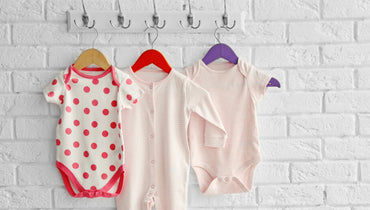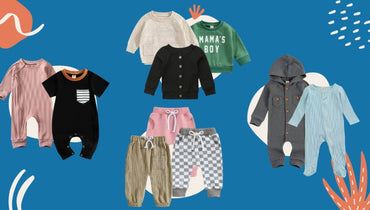Mini Cart
9 months of pregnancy and childbirth have passed, and now you are at home with a long-awaited baby. There are millions of questions in your head of how and what to do. The first month of a newborn’s life is perhaps the most exciting for parents. What weird things parents should know first of all to create the best conditions for their newborn — read below.
1. Cradle Cap
While in the womb, the newborn was surrounded by water for a long time. After birth, the baby's body gets used to the air space. The same happens with the baby’s scalp. After some time, the skin will begin to produce the required amount of protective secretions and the lipid metabolism will normalize. Normally, the skin peeling can last from a month to a year. So, a young mother needs to be sure to exclude any factors that cause peeling:
- Frequent use of soap;
- Chlorinated water;
- Unsuitable washing powder;
- Synthetic underwear;
- An abundance of sun rays;
- Dry air;
- Excessive sweating;
- Allergy;
- Lack of vitamins.
Cradle cap can spread throughout the body from the head to the feet, but it does not pose any threat to the newborn baby. To get rid of the peeling skin faster, doctors recommend wearing hats in both hot and cold weather. Follow the link to find the organic newborn first clothes.

2. Poop Issues
Poop issues worry almost all parents, especially those who became a mom and dad for the first time. The first poop appears within the first twelve hours after birth and is called meconium. This thick mass usually causes great concerns of parents due to its dark green (olive) color. However, this is 100% normal and after 2-7 days, the poop becomes mushy and yellow. Such a rapid change is caused by breastfeeding and normalization of the digestive system.
The first signs of trouble are usually the anxiety of the baby and his crying. The child has a swollen belly, he shakes his legs, and loudly screams. He may calm down for a short time, and then everything starts again. All these signs may signalize about the poop problems, so it is worth calling your doctor.
3. Breastfeeding on Demand
How often your baby is fed can vary significantly. For example, some newborns do not want to be fed frequently for the first two days. However, the frequency of feedings may then increase, especially in the first few weeks. This is quite normal: if you feed your baby whenever he is hungry, you will always have as much milk as the baby needs. This is called “feeding on demand”. With each feed, signals are sent to the brain and then to the mammary glands, stimulating lactation.
If your baby is fed less than 6-8 times a day, you may notice that the mammary glands are not producing enough milk to feed the baby. Therefore, you should apply the baby to the breast whenever he is hungry. If you have fed your baby, but he is still anxious, check if the diaper needs to be changed, or perhaps the baby just wants some hugs. If it does not calm the baby, then attach it to the breast again.
4. Weird Groaning Sounds
Newborns are by no means quiet, even when they are sleeping. Most sounds are caused by too much air passing through the narrow nasal paths. Here are our favorite, precious sounds:
- gurgling;
- combination of snoring and gurgling;
- purring.
During sleep, the narrow airways relax and become even narrower. This leads to the fact that each inhalation and exhalation has a musical sound. Don’t forget about this wonderful bird-like whistling. Enjoy these sounds as they won’t stay with you for a long time.
However, a blocked nose can cause a lot of breathing difficulties as newborns are forced to breathe through their nose rather than their mouth. One of the reasons newborns sneeze frequently is the need to clear their nasal passages. Here’s how you can make breathing easier for your newborn:
- Place your baby on his tummy with his head slightly turned to the side. In this position, babies breathe better because it allows the tongue and saliva to make more place for air to pass;
- Keep the area where your baby sleeps as free of dust as possible. Remove feather pillows and dozens of toys that are littered;
- Keep your baby away from irritants such as cigarette smoke, paint and exhaust fumes, aerosols, perfume, and hairsprays. Do not allow smoking in the house where your child is;
- Use a nasal spray or drops to pull the nasal secretions away, so that the secretions move from the back of the nose to the front, where you can easily remove them.
5. Jerky Movements
The nervous system of a newborn is still immature, which is why he cannot perform coordinated movements. The baby’s nerve fibers are just beginning to be covered with special myelin covering, which is responsible for the speed of transmission of nerve impulses to the muscles. The faster the transfer takes place, the smoother the movements of the crumbs become. Until the nervous system has formed, a small child can be in constant motion, which sometimes continues even during sleep. This is the so-called Moro reflex. It lasts up to 4–5 months and usually occurs in response to harsh sounds or changes in body position. As a rule, chaotic movements disappear in the second month of life.
To help your baby adapt to the new world, doctors recommend doing a strengthening massage, as it will contribute to the development of the muscular system and coordination of movements.
6. Oddly-Shaped Heads
The baby’s head is a unique anatomical object. The skull of a normal child is made up of seven separate soft bones, which like puzzles fit into each other. They allow the skull to grow and also give it the necessary flexibility during the challenging journey through the narrow birth canal. Once born, this structure of the skull allows the brain inside to grow. If we are talking about natural childbirth, then the normal shape of the head can be:
- Egg-shaped
In this case, the baby’s head is slightly elongated at the back and resembles an egg in shape. If there are no other deviations, then children with such a skull are completely healthy, and the deformation passes quickly.
- Slopping
In this case, the skull of the newborn has a sloping nape and a bulge at the crown of the head. This head shape is also normal and should not be a cause for serious concern. It occurs during the natural childbirth, when the baby in the womb is placed upside down and facing the mother’s belly.
- Round-shaped
If we are talking about the cesarean section, then all healthy babies born this way have the correct round head shape. Any deformation of the baby’s head, in this case, must be carefully checked by doctors to exclude possible risks of developing serious diseases.
7. Big Genitals
When mothers are caring for a newborn girl, they may notice breast swelling and vaginal excretion. This condition is associated with a hormonal crisis that lasts up to 3 weeks. At this time, estrogens obtained in the mother’s womb are excreted from the baby’s body. These excretions appear in the first week after childbirth.
When caring for a newborn girl, a sticky, dense substance can be seen in the labia. This is the original lubricant, the so-called “smegma”. There is nothing dangerous in this substance. To cleanse the skin, wipe off it with a damp cloth without pressure. Several procedures may be needed, there is no need to rush.
This condition does not require treatment, but hygiene is important. In parallel with the secretions, the mammary glands swell. The genital crisis is natural, but if symptoms other than those described above appear (bad-smelling excretion), you need to contact your pediatrician to exclude complications.
8. Blood in the Diapers
If mom sees blood on the diaper, it is necessary to determine the source of the bleeding and its cause. Blood discharge can be caused by:
- Skin lesions of the genitals, anus or mucous membranes of the gastrointestinal tract, organs of the urinary system and vagina;
- Blood system disorders;
- Alimentary reasons;
- Some other diseases.
However, blood spots may not cause trouble due to several reasons. For instance:
- Hormonal crisis: occurs in the first days and weeks of the independent life of an infant. It is associated with a decrease in the level of maternal estrogens in the body of the crumbs.
- Cracked nipples: many women have rather delicate skin. So, the nipples get injured during the feeding and upon the contact with clothing. Drops of blood are swallowed with milk. Therefore, the child’s poop may contain blood.
- Eating foods with red pigment or taking medications;
- Complicated diaper dermatitis and other diseases accompanied by damage to the skin.
All diseases that lead to skin damage are monitored and treated by a pediatrician. The baby should be provided with high-quality care (washing the wounds with antiseptics, treatment with antibacterial healing ointments, etc.).
9. Crossed Eyes
Parents often worry that their newborn baby has crossed eyes. Indeed, the eyes of infants up to 6 months of age squint from time to time. And that’s okay. In the first 2-4 weeks of life, the baby’s sight is not clear enough to concentrate on something for a long time. Therefore, parents often think that newborns are looking over them. However, by the fourth week of life, your baby will be focusing on your face, even if you swing it in your arms.
To a greater extent, the development of sight occurs in the brain, and not in the eyes themselves. One of the biggest challenges for the developing brain is the analysis of visual signals from one side to the other. Nerve signals from the eyes travel through the optic nerves and get to both hemispheres of the brain. To understand these signals, the two hemispheres must interact, comparing information, and coordinating the movement of the eyes in the desired direction. However, by 2 months your baby should already master this ability.
10. First Crying
The first crying is the way the child communicates with the outside world. It should happen immediately after he leaves the mother’s womb. At this moment, his lungs expand, but later his crying turns into the Morse code for others, signaling the baby’s physical or mental discomfort. The more time mom spends with the baby, the faster she will learn to recognize the cause of anxiety from the very first sounds.

It is believed that the louder the baby cries, the more actively its respiratory and cardiovascular systems develop, and the necessary processes are triggered in the cerebral cortex. If the child does not calm down for a long time, it is impossible to ignore — it is necessary to find the reason. By the way, tears appear only by the third week after birth.
Mom's tender words, hugs, and breastfeeding, in turn, calm the baby down.
In Conclusion
After the birth, a newborn is chaotically moving the arms and legs, which are not yet straightened, while the fingers are clenched into fists. During this time, his sense of sight and hearing continue developing, as well as their movement skills. He can hear your voice and make single vowel sounds, hold his attention on an object, but only for a short time. This and many other things seem to be weird for you, however, we want to assure you that it is natural.
If you have serious reasons for worries, do not hesitate to contact your doctor and consult on the state of your newborn. Sometimes, it is better to do more than ignore your worries regarding your baby.
What newborn issues cause your major concerns? Share your worries with us in the comments.









